the history of yeovil's pubs
PUBS HOME PAGE |
PUBS INTRODUCTION |
PUBS BY NAME |
BEERHOUSES |
coronation hotel & vaults
31 Middle Street
The Coronation Hotel & Vaults (marked 'A' on the map below) was an impressive albeit relatively short-lived establishment in Middle Street, on the north side of the Triangle. It was built around the year 1900 on the site of the old Blue Ball Inn, itself a pub with an apparently short lifespan. The Coronation Hotel & Vaults, owned by Mitchell, Toms and Company, opened on Thursday 17 July 1902 and was designed by architect Arthur Yeomans.
The Coronation was a large, three-storey building in brick with stone string courses, quoins and mullioned windows under a tiled roof that sported a wooden lantern with cupola. There was a decorative stone frieze just below eaves level that reach down to the midpoint of the second floor windows. The ground floor windows were set back behind an attractive four-arch colonnade on Corinthian columns.
On the ground floor just under half the frontage was occupied by a retail outlet, initially Godfrey & Co's piano shop, followed by Smart's furniture store.
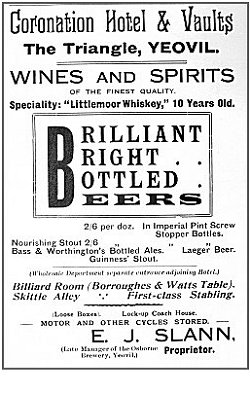 Finally,
check out the
advertisement at
left from the
Whitby & Sons
Yeovil Almanack
Advertiser of
about 1920, when
EJ Slann (late
Manager of the
Osborne Brewery
in Sherborne
Road) was the
Licensee. Two
shillings and
sixpence -
that's 12½ pence
- for a dozen
pint bottles of
'nourishing'
stout. A penny a
pint - it's no
wonder my great
granddad died
propping up a
bar (albeit not
this one).
Finally,
check out the
advertisement at
left from the
Whitby & Sons
Yeovil Almanack
Advertiser of
about 1920, when
EJ Slann (late
Manager of the
Osborne Brewery
in Sherborne
Road) was the
Licensee. Two
shillings and
sixpence -
that's 12½ pence
- for a dozen
pint bottles of
'nourishing'
stout. A penny a
pint - it's no
wonder my great
granddad died
propping up a
bar (albeit not
this one).
Also of note in this advertisement is the fact that the Coronation Hotel boasted a billiard room and, unusually for fairly modern town centre pubs and hotels, it also had a skittle alley.
The Coronation Hotel & Vaults was finally demolished around 1965 as part of the Glovers Walk shopping complex redevelopment (see final photo). It had served Yeovil for only some fifty years before succumbing to the 'progress' of 1960's concrete and steel architecture - unfortunate for such a grand building and what was surely the most architecturally impressive of Yeovil's watering holes.
Check out the fifth photograph below showing the site today and wonder if the 1960's concept of concrete and steel had it right or, perhaps, not.
![]()
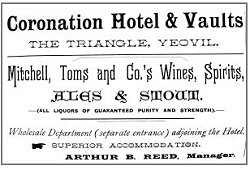 Of the licensees
listed at the
bottom of this
page the first
two, Arthur
Bowler Reed and
T Bown, must
have been
brought in as
managers since
neither appear
in the census
either before or
after their
tenancies. Henry
Simmonds, listed
as proprietor in
the 1911 census
had come from
Redhill, Surrey.
Of the licensees
listed at the
bottom of this
page the first
two, Arthur
Bowler Reed and
T Bown, must
have been
brought in as
managers since
neither appear
in the census
either before or
after their
tenancies. Henry
Simmonds, listed
as proprietor in
the 1911 census
had come from
Redhill, Surrey.
Edward James
Slann was born
in Highnam,
Gloucestershire
on 5 March 1869,
the son of
butler Reuben
Slann and his
wife Sophie née
Francis. For the
first twenty
years or so of
his life Edward
lived in the
butler's lodge
at Churcham,
Gloucestershire
with his parents
and siblings. On
2 April 1896 he
married Mary
Mayo at St
James' church,
Gloucester. In
1900 he was
noted as a
licensed
victualler and
by 1911 he and
Mary were living
at 20 Sherborne
Road with their
two sons and
Edward was
manager of the
Osborne Brewery.
By 1915 he was
the proprietor
of the
Coronation Hotel
and died there
on 19 April
1920. Mary took
over the license
on Edward's
death but it is
not known how
long she stayed
in Yeovil.
Certainly by
1935 Roland
Arthur Adams was
licensee and
remained so
until the late
1940's.
map
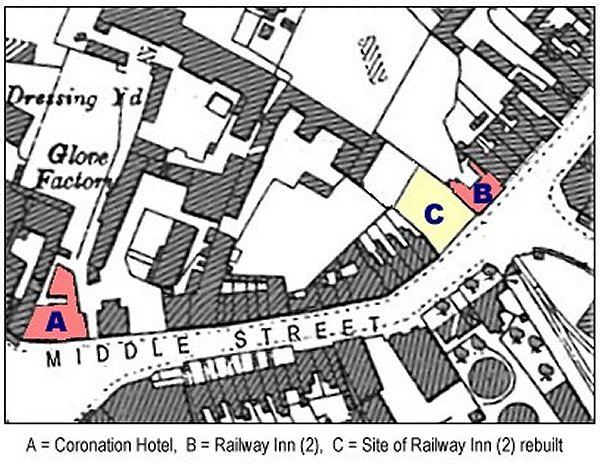
gallery
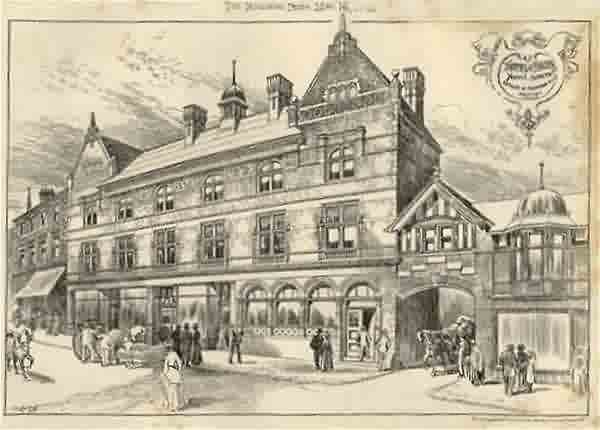
Courtesy of Rob
Baker
A perspective drawing by architect Arthur Yeomans and published in the 16 May 1902 edition of the Building News.
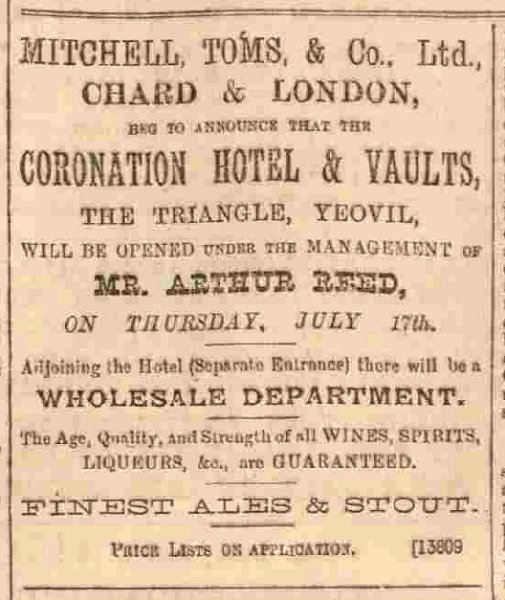
Courtesy of
Rob Baker
The notice of opening of the Coronation Hotel & Vaults in the Western Gazette's edition of 11 July 1902.
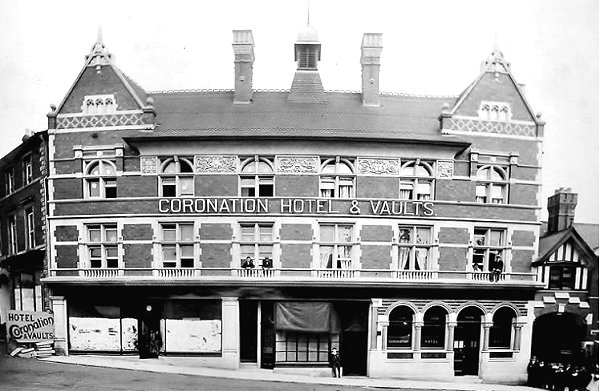
Probably one of the first photographs of the newly-built Coronation Hotel & Vaults, this publicity postcard probably dates to between 1900 and 1903 - even before Godfrey & Co started their piano and organ shop as seen in the following photograph. The photographer hadn't got a shift lens or couldn't position his camera far enough away which is why the building appears to lean out at both sides.
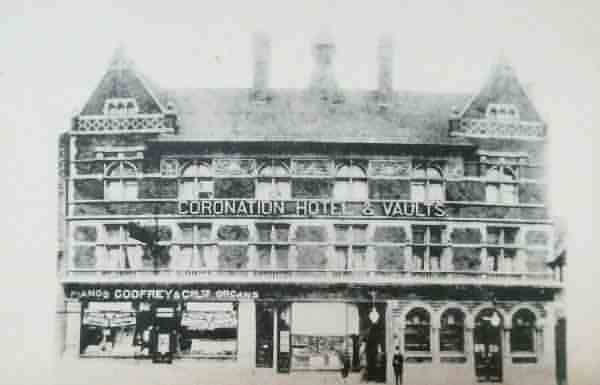
This postcard was sent in 1906, by which time Godfrey & Co Ltd were selling their organs from the shop set within the hotel building.
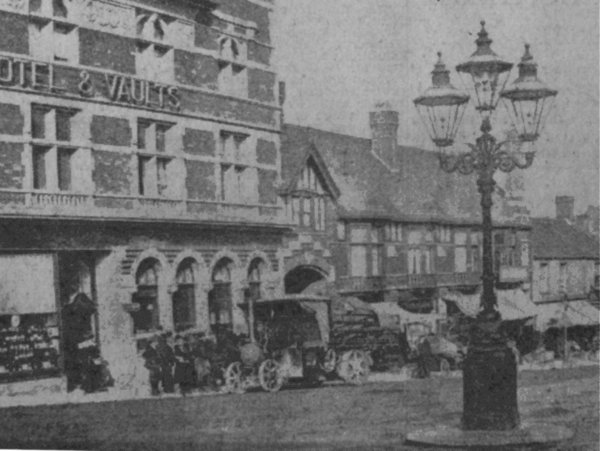
Courtesy of Olly
Ewens
The main interest of this photograph of about 1902 is the steam-drawn wagon delivering beer to the Coronation Hotel. Attracting a small crowd at the time, this was one of the few exceptions to horse-drawn vehicles that were the norm of the time.

An early photograph, taken about 1905, just after the Coronation Hotel & Vaults opened with Godfrey & Co Ltd's piano and organ shop on the ground floor.
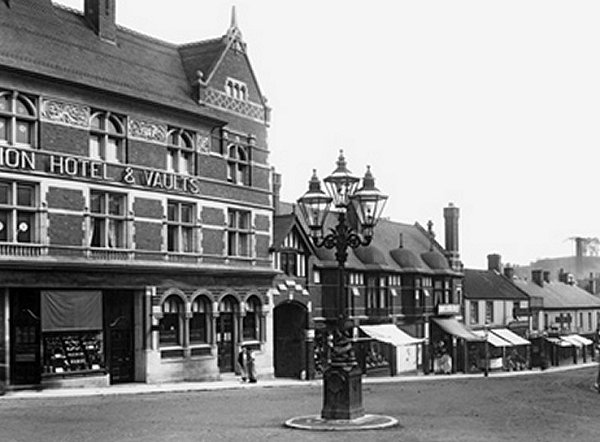
This photograph dates to about 1905 - notice the nice colonnade of the ground floor windows and the decorative frieze between the second floor windows. See next photo for details on the lamp.
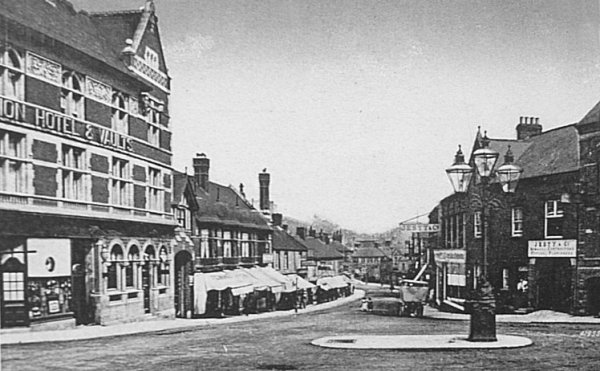
Photo from the Triangle looking down Lower Middle Street shows the Coronation Hotel around 1905. The large three-light Sugg gas lamp was donated to the town by the Yeovil Gas and Coke Company in 1887 to celebrate Queen Victoria’s Golden Jubilee but was removed when the underground toilets were built – the location is now the bandstand.
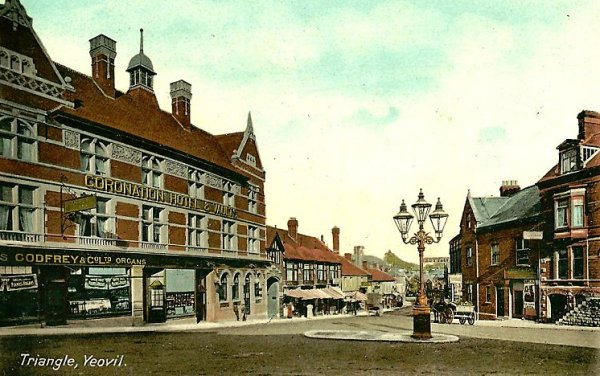
From my
collection. This
photograph
features in my
book "A-Z
of Yeovil"
A hand-coloured postcard of about 1910 showing pretty much the same view as the previous photo although the trees in the background make it look like Glastonbury Tor has come to Yeovil.
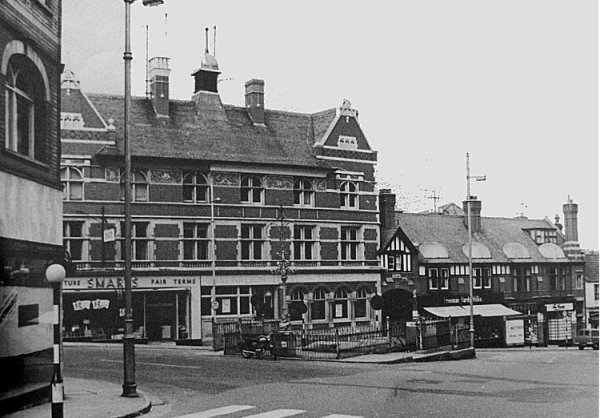
The Coronation Hotel around 1950. The Hotel is lacking its signage and Godfrey's piano shop has been replaced by Smarts furniture store. Note too, that the old Victorian Sugg lamp in the two photographs above has now been replaced by the smart new underground toilets.
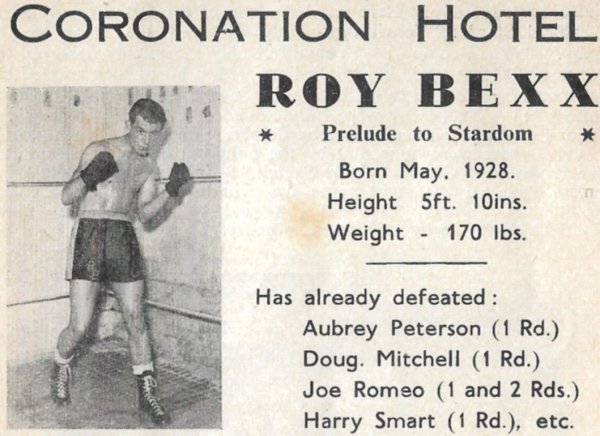
Courtesy of Alan
Jackson
Alan says "One of the very few professional boxers from Yeovil was middle weight Roy Bexx pictured here as an 18 year old in 1948. Roy’s Father was the licensee of the Coronation Hotel in Middle Street hence it being the location for some of Roy’s exhibition fights. Roy had 19 Professional fights from 1947 to 1952 with 10 wins, 8 defeats and 1 draw, and a 37% K.O. rate, not bad for a local lad."
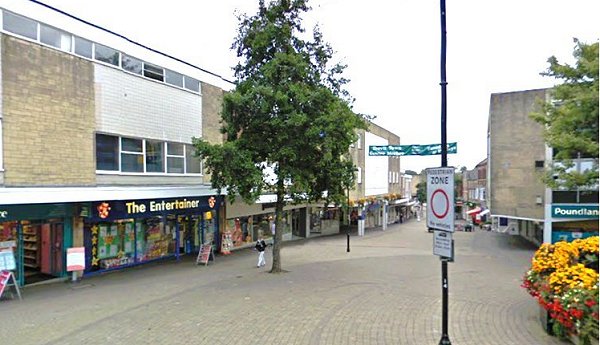
The same scene in 2009. Just think that this featureless mass of 1960's concrete and reconstructed stone cladding replaced such a wonderful turn-of-the-century building. The toilets have gone, to be replaced with the bandstand - decorated with flowers at right - far nicer on the olfactory senses.
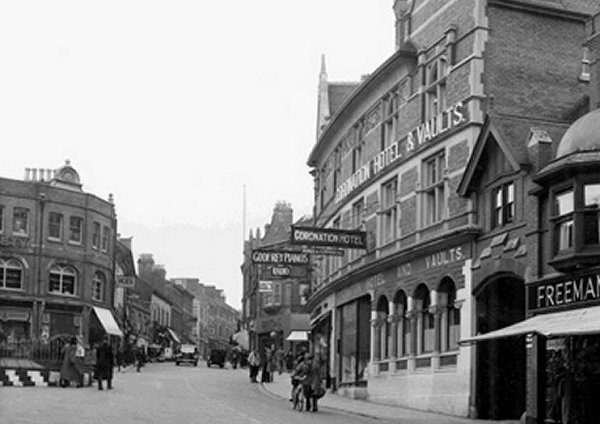
This late 1930s or early 1940s photograph is taken from the Triangle and looks up Middle Street with the Coronation Hotel & Vaults at right and the Co-operative building, later Porter Black's, at left - in front of which the underground toilets are decorated in mock Art Deco ziggy-zaggy black and white presumably so that cars don't drive into it, presumably in the blackout - as if.
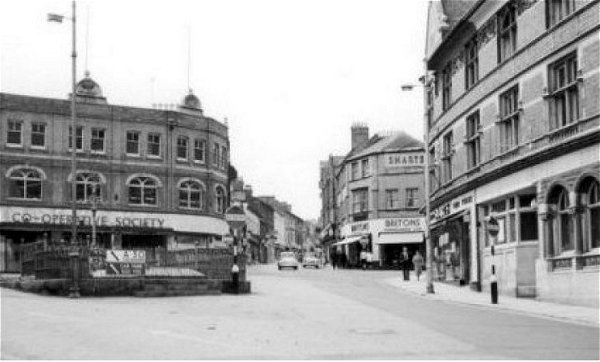
The Co-op building (later to be Porter Black's) is still there as are the old underground toilets in this photo of the late 1950s. The Coronation Hotel at right is lacking its signage. Note that the black and white Art Deco painting on the toilets has gone - presumably because traffic didn't bash into it after all.
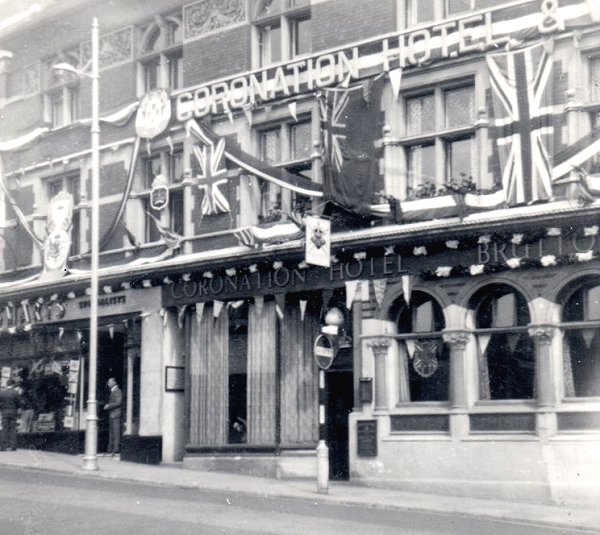
Many thanks to Alan Tower who sent me the above photo of the Coronation Hotel bedecked in celebration of the coronation of Queen Elizabeth II - how apt. It was taken by Alan's mum and dated 2nd June 1953.
The sculpted column capitals and the columns discovered in the July/August 2022 excavations (see below) are clearly seen in-situ.
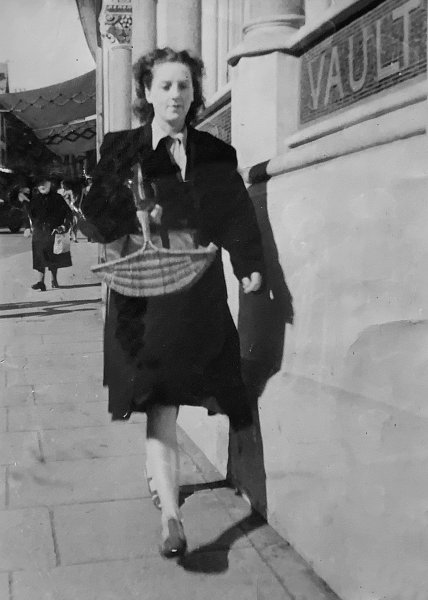
Courtesy of
Vivien and John
Cornelius
This is John's mother, Gladys Cornelius, walking past the Coronation Hotel & Vaults (I'm guessing in the 1950s).
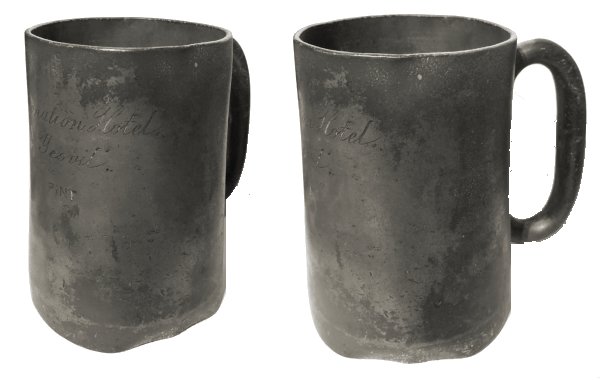
From my
collection
Two views of a one-pint tankard inscribed "Coronation Hotel" over "Yeovil" over "Pint".
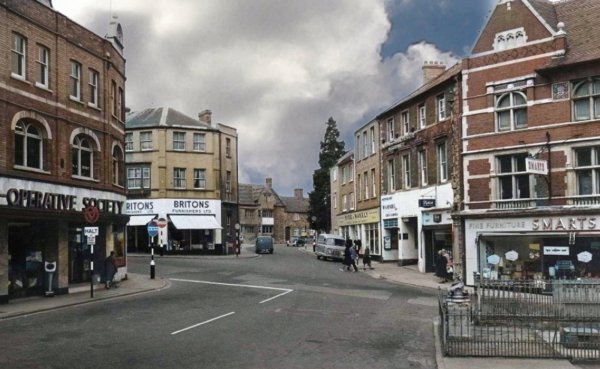
From the Cave
Collection
(colourised),
Courtesy of South Somerset Heritage Collection
This photograph, taken about 1968 from the Triangle, shows the entrance to Vicarage Street at centre. At left is the old Co-Operative store and offices (later Porter Blacks) next is the entrance to Middle Street, Britons shop was earlier Belben's Bazaar, later the Woolwich Building Society and is now a bookmakers. To the right are buildings still existing and now occupied by the Abbey Building Society, at far right is the Coronation Hotel & Vaults in front of which are the underground toilets, later the location of the much-underused bandstand (removed during the years-long 'Yeovil Refresh' project).

From the Cave
Collection
(colourised),
Courtesy of South Somerset Heritage Collection
And there it was - gone! The Coronation Hotel being demolished, circa 1965.
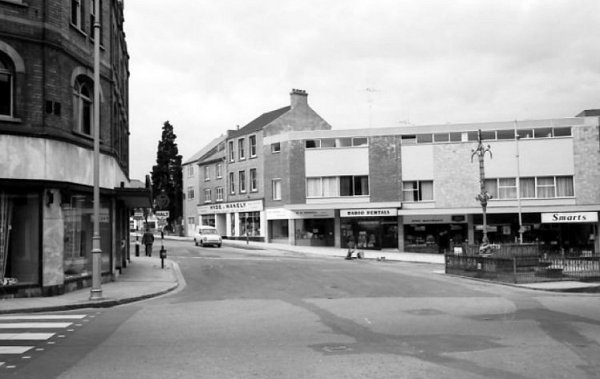
The 1960s really does have a lot to answer for!
The 2022-20?? Excavation (A "Time Team Special")
During the summer of 2022 the Triangle is going through a re-vamp (Update: February 2024 and it still looks like a bomb site).
During the works a possible cellar was uncovered outside the Entertainer built on the site of the Coronation Hotel, which itself was built on the site of the Blue Ball Inn. Personally, I think that if it does turn out to be a cellar, it is likely to pre-date both the Coronation and the Blue Ball (it may be just a coal hole or even part of the Victorian sewerage system - time will tell). It should also be remembered that most properties in Middle Street had cellars which, despite local legends did not link up, although the occasional short tunnel has been discovered (see the photos at the bottom of this page).
The following photographs were taken on 27 July 2022.
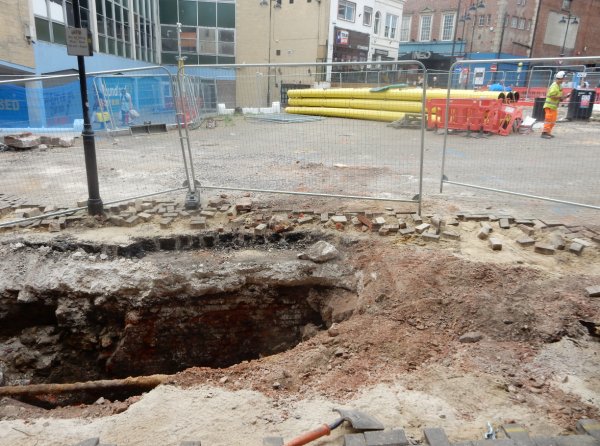
Taken from outside the Entertainer shop and looking across the Triangle, this photograph shows the relative position of the excavation.
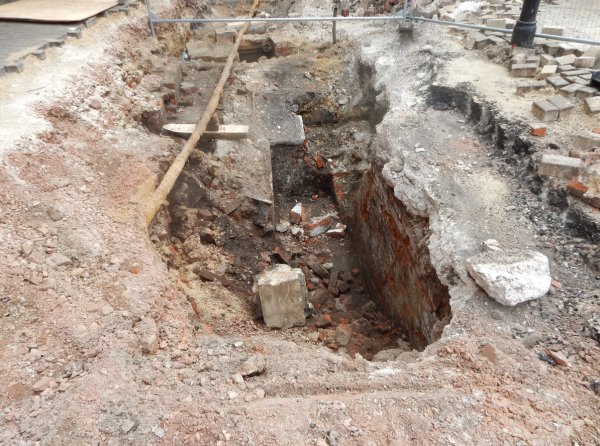
Looking along the excavation from the western end.
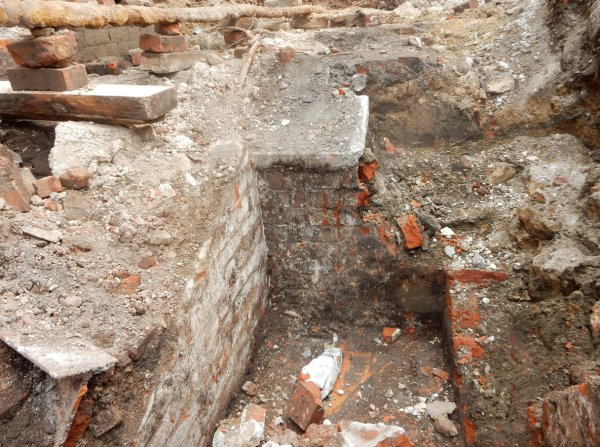
Looking towards the western end of the excavation.
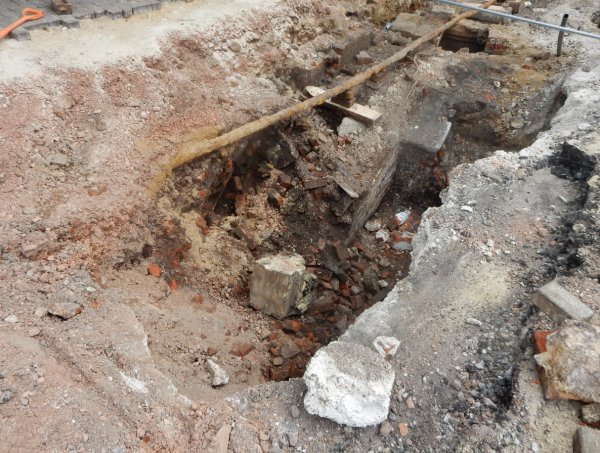
Looking into the excavation from the western end. Notice the lump of stone in the centre.
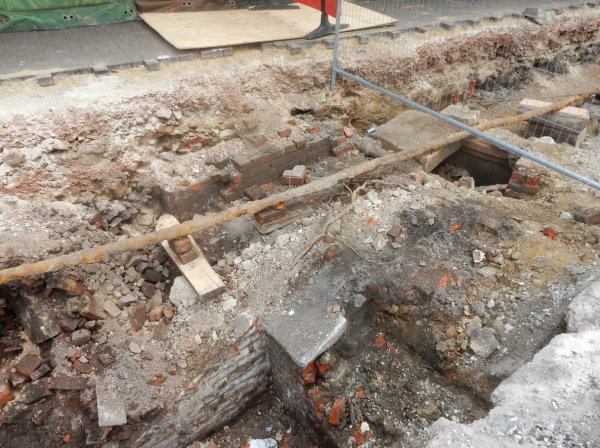
Looking into the excavation from outside the Entertainer shop.
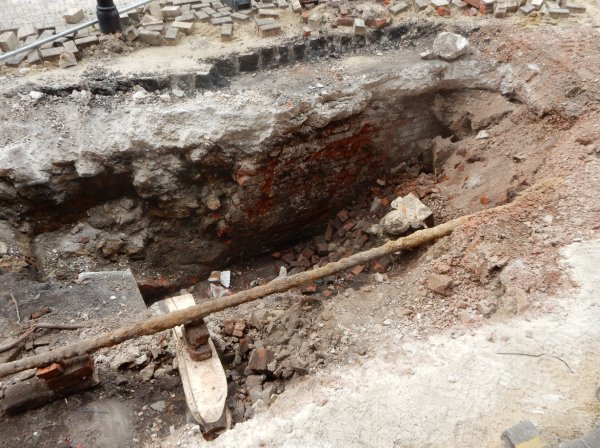
Looking into the excavation showing the depth excavated so far in comparison with the modern ground level seen at the top left of the photograph. The lump of stone seen in the photograph before last is now seen to be carved.
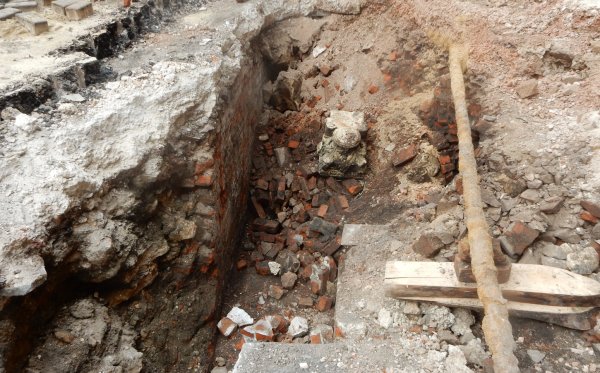
A better view of the carved stone.
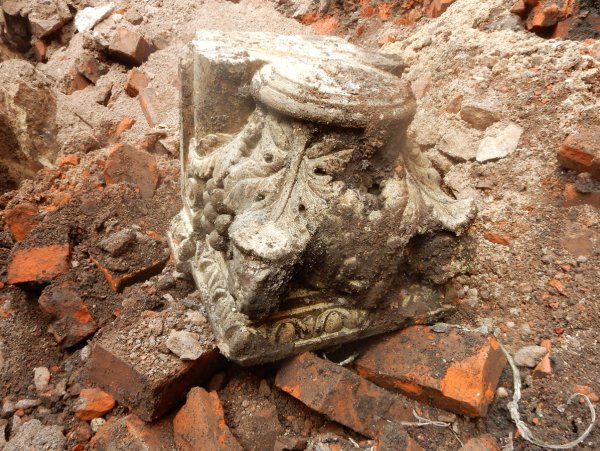
It turns out that the stone is an upturned column capital carved with an acanthus leaf design. It would have formed part of the window in the bottom right corner (looking from the Triangle) of the Coronation Hotel and Vaults - see various photographs above.
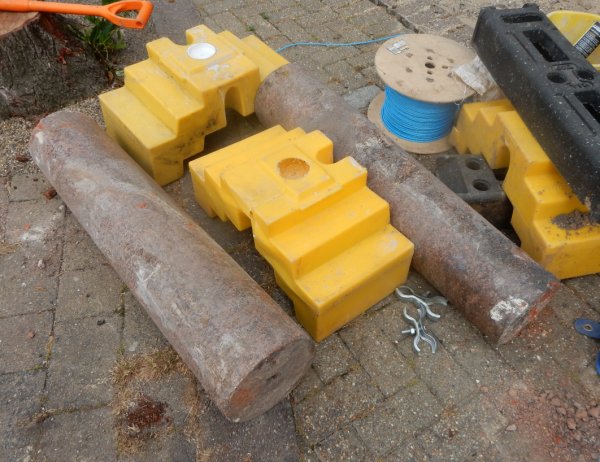
Two of the (red marble ?) columns that were a feature of the window were found in the excavation.
Many thanks to the site manager who took these photos for me.
licensees
1903 – Arthur
Bowler Reed –
Manager
(Whitby's Yeovil
Almanack
Advertiser 1903)
1907 – T Bown
(1907 Yeovil
Directory)
listed at 30
Middle Street
1911 – Henry
Simmonds - Hotel
Proprietor (1911
census)
1915 – Edward
James Slann
(Whitby's Yeovil
Almanack Adviser
1915)
1919 – EJ Slann
– Hotel
Proprietor
(Telephone Book
1919) listed as
Coronation Hotel
1920 – EJ Slann
– Proprietor (Whitby
& Sons Yeovil
Almanack
Advertiser 1920)
1923 – Mary Stann (Kelly’s
1923 Directory)
listed as
Coronation Hotel
1935 – Roland
Arthur Adams
(Kelly's 1935
Directory)
1936 – RA Adams
(1936 Yeovil
Directory)
listed as
Coronation Hotel
1938 – RA Adams
(1938 Yeovil
Directory)
listed as
Coronation Hotel
1947 – RA Adams
(1947 Yeovil
Directory)
listed as
Coronation Hotel
1949 – JC Bexx
(Kelly’s 1949
Directory)
listed as
Coronation Hotel
1951 – JC Bexx
(1951 Yeovil
Directory)
listed as
Coronation Hotel
1954 – Levi
Bates (1954
Yeovil
Directory)
listed as
Coronation Hotel
1957 – EL
Salkild (1957
Yeovil
Directory)
listed as
Coronation Hotel
1965 – Licensee
not named (1965
Yeovil
Directory)